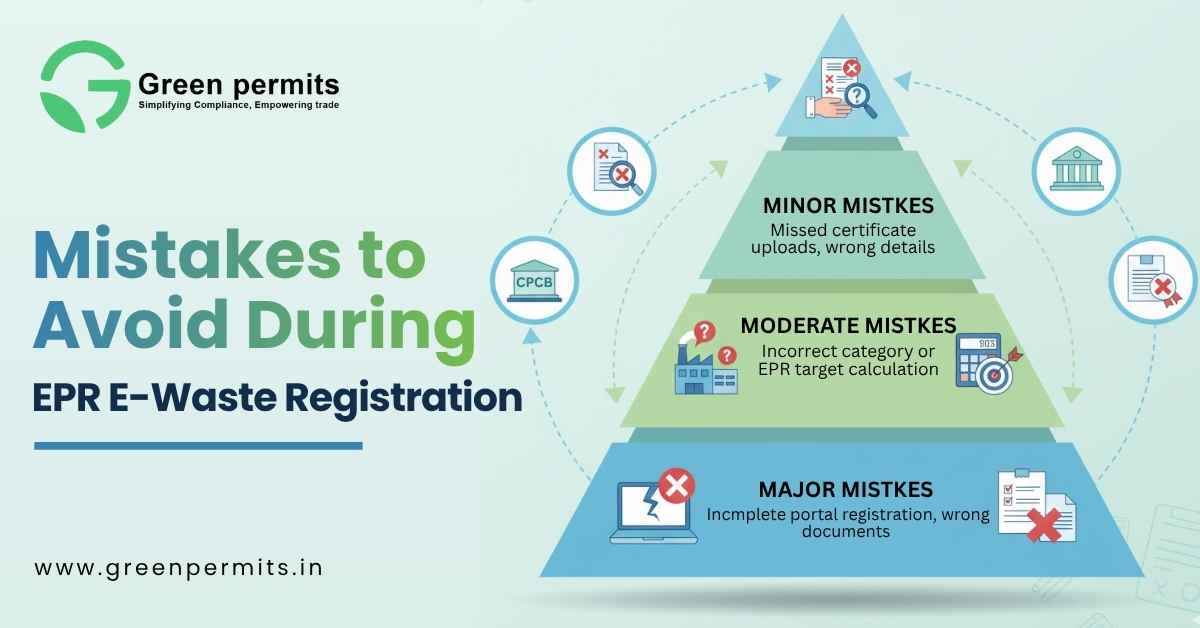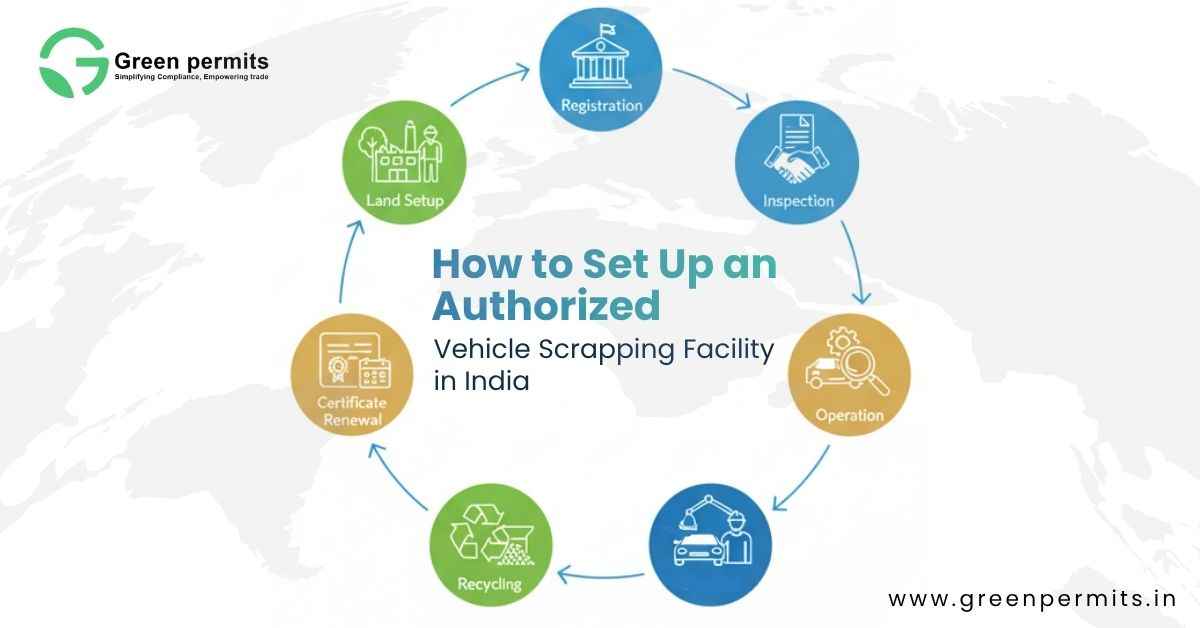When Ankit from TechNova Electronics applied for his E-Waste EPR registration, he thought everything was fine. But a week later, CPCB flagged three issues — his GST address didn’t match the facility address, his Consent to Operate (CTO) had expired, and the uploaded facility video link was inactive.
Those minor errors delayed his registration by two months and disrupted supply to key distributors.
This story is not unique. Many Indian businesses face unnecessary delays due to small, fixable mistakes during EPR registration. This guide will walk you through the most common pitfalls and how to avoid them.
Understanding EPR E-Waste Registration in 2025
The E-Waste (Management) Rules, 2022, implemented by the Ministry of Environment, Forest & Climate Change, made Extended Producer Responsibility (EPR) mandatory for four types of entities:
- Manufacturers
- Producers
- Recyclers
- Refurbishers
Every entity dealing with electronic products or components must register on the CPCB EPR portal (https://eprewastecpcb.in) before operating legally in India.
EPR registration ensures traceable recycling, waste accountability, and circular economy compliance. Without it, companies risk license suspension and legal penalties.
The CPCB portal manages end-to-end processes — registration, target allocation, certificate trading, and annual returns — making accuracy in every step critical.
Common Mistake #1 – Mismatched Addresses and Documents
One of the most frequent reasons for rejection is a mismatch between the address entered on the CPCB portal and the address mentioned in your official documents — such as GST, CTE (Consent to Establish), CTO (Consent to Operate), and Authorization certificates.
Many applicants mistakenly use their corporate office address instead of the operational facility address. CPCB requires that every supporting document reflects the same location as the facility where manufacturing or recycling takes place.
How to fix it:
- Cross-check the address on your GST certificate before submission.
- If your production and office addresses differ, use the manufacturing/recycling site address for registration.
- Re-upload corrected documents instead of editing old files to maintain clarity.
Common Mistake #2 – Missing or Incomplete Document Uploads
The EPR portal application requires several supporting documents, and missing even one can hold your file in review. Commonly skipped items include:
- CA-certified sales data or invoice summary (for producers)
- RoHS self-declaration confirming product compliance
- Authorization under Hazardous Waste (Management) Rules 2016
- Updated CTO or expired licenses
- Inactive or missing geotagged videos of the recycling/refurbishing facility
Best practice:
Before starting the online form, prepare a digital folder with all documents in PDF format. Review the CPCB checklist on the portal and tick off each item. A complete and organized upload ensures your application moves smoothly through evaluation.
Common Mistake #3 – Ignoring the Correct Fee Structure
Many applicants overlook or misunderstand the CPCB fee categories. Registration and maintenance fees vary by entity type and production capacity.
| Entity Type | Activity | Fee (₹) | Validity | Notes |
|---|---|---|---|---|
| Recycler / Refurbisher | New registration | 15,000 | 5 Years | Annual Maintenance ₹5,000 |
| Producer (<50 MT Target) | Registration | 2,500 | 5 Years | Increases with target capacity |
| Producer (>5000 MT Target) | Registration | 15,00,000 | 5 Years | Highest fee slab |
| Amendment / Addendum | Profile update | 3,000–10,000 | — | Based on modification type |
Many producers forget to pay their Annual Maintenance Charge (₹5,000), which later restricts access to return filing and certificate generation. Always save a screenshot of the payment receipt for your records.
Common Mistake #4 – Incomplete or Incorrect Application Form
The CPCB has a strict evaluation process with a 30-working-day review window. If your application is incomplete or inaccurate, the system issues a “shortcoming notice.” You must respond and rectify within 7 working days. Missing this window can result in automatic closure, forcing you to start over.
Key points to check before submission:
- Name and contact details of the authorized person are correct.
- All uploaded files are readable and not password-protected.
- The recycling/refurbishing capacity matches your Consent to Operate document.
- You’ve declared all relevant EEE categories in the list.
Treat the form as a compliance declaration — not just a procedural step. Every detail you submit is auditable later.
Common Mistake #5 – Inactive Geotagged Videos or Wrong Coordinates
CPCB requires geotagged photos and operational videos of the facility, showing the building, machinery, and working condition. If your uploaded video link doesn’t open or the GPS data doesn’t match your stated address, the application may be flagged as “willful concealment.”
How to ensure accuracy:
- Record videos with a GPS-enabled smartphone or camera.
- Upload them to a reliable cloud link (Google Drive, OneDrive) and keep sharing settings public.
- Double-check coordinates using Google Maps before submission.
Common Mistake #6 – Skipping Quarterly and Annual Returns
Registration is only the first step. You must continue to stay compliant by filing quarterly and annual returns through the CPCB portal.
| Return Type | Filing Deadline | Key Requirements | Frequent Errors |
|---|---|---|---|
| Quarterly | Within 15 days of quarter end | Upload transaction summary | Filing out of sequence |
| Annual | By 30 June each year | Awareness tab and campaign proof mandatory | Not uploading supporting documents |
Many users attempt to file the annual return without completing all four quarterly returns — which the system doesn’t allow. Others skip the awareness tab, which is mandatory for producers. Non-compliance can result in renewal delays or even revocation of EPR status.
Common Mistake #7 – Neglecting Authorized Person Updates
If your compliance officer, director, or consultant changes, CPCB must be informed immediately through a profile amendment request on the portal. Using outdated email addresses or inactive contact details causes missed OTPs and login issues.
Your “authorized person” is the only official contact CPCB recognizes for communication — not your consultant or agency.
Common Mistake #8 – Poor Record Maintenance and Verification Readiness
Within three months of registration, CPCB or the respective State Board may conduct a physical or virtual verification to confirm the authenticity of your application.
Companies often face problems when they cannot produce:
- Fire safety certificates
- Waste disposal records
- Calibration or maintenance logs of machinery
- Proof of occupational safety measures
Maintaining an internal compliance folder with all these records ensures smooth inspections and builds credibility for renewals.
Common Mistake #9 – Delayed Replies to CPCB Queries
The portal’s dashboard displays messages, checklists, and deficiency notes. Ignoring them leads to extended processing times. Designate a staff member to check your CPCB login every week. Respond to clarifications promptly and upload revised files within the given window.
Common Mistake #10 – Overlooking RoHS & Awareness Obligations
Under Rule 6(3) of the E-Waste Rules, producers must implement consumer awareness programs and confirm Restriction of Hazardous Substances (RoHS) compliance.
Skipping these steps can affect your EPR target calculation and renewal. Include a plan for awareness workshops, campaigns, or product labeling within your annual return.
Why Avoiding These Mistakes Matters
Avoiding these issues isn’t just about getting approved faster. It’s about maintaining long-term credibility and staying audit-ready. A clean registration record helps you:
- Renew without delays
- Avoid environmental compensation penalties
- Strengthen ESG and sustainability ratings
- Build trust with vendors and regulators
When your compliance documentation is well-maintained, it also simplifies future expansions or new product launches under the same portal.
Conclusion
EPR registration doesn’t have to be stressful. Most delays happen due to small administrative oversights that can easily be avoided with guidance. Working with experts who understand CPCB protocols can save weeks of back-and-forth communication and ensure your business stays compliant at all times.
Book a Consultation with Green Permits
📞 +91 78350 06182 | 📧 wecare@greenpermits.in
Book a Technical Call with Expert
FAQs
It’s a CPCB approval required for manufacturers, importers, recyclers, and refurbishers to ensure responsible collection and recycling of electronic waste.
Any business that makes, sells, imports, or recycles electrical or electronic equipment in India.
Usually 25–30 working days, if all documents and videos are correct.
Five years. Apply for renewal 120 days before expiry.
Most are rejected due to address mismatches, missing documents, or inactive geotagged videos.
You may face suspension or penalties. Always file quarterly returns before the annual one.



